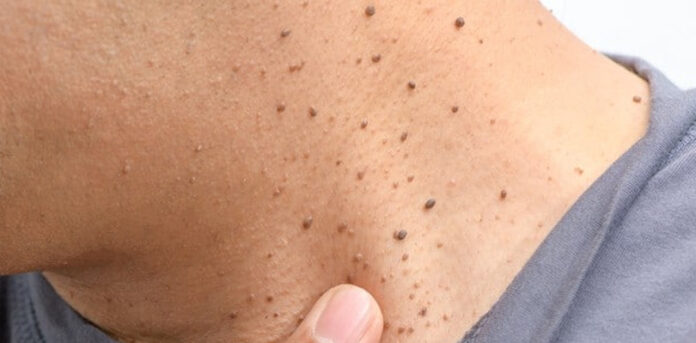Discover the ultimate guide to removing skin tag and unlocking the secret to flawless skin. Skin tags, those tiny, benign growths that often appear in inconvenient places, can be a source of frustration and self-consciousness. Fear not, for we have gathered a wealth of knowledge and practical solutions to help you bid farewell to these unwanted skin tags. While they are harmless, their presence can sometimes affect our confidence and self-esteem. Thankfully, with the right knowledge and effective techniques, you can bid farewell to these pesky skin tags and reclaim the beauty of your skin.
In this informative blog post, we will delve into the most effective tips and treatments available, empowering you to take control of your skin’s appearance. Say goodbye to discomfort and embarrassment as we explore safe and proven methods, home remedies, and professional interventions to help you achieve the smooth, beautiful skin you desire. Get ready to embark on a transformative journey toward regaining your confidence and revealing a more radiant you!
What Is Skin Tag
A skin tag is a small, benign growth that commonly appears on the surface of the skin. Also known as acrochordons, skin tags are typically flesh-colored or slightly darker and have a soft, fleshy texture. They often occur in areas where skin folds or rubs against skin or clothing, such as the neck, underarms, groin, eyelids, and breasts. Skin tags are harmless and painless, but some individuals may choose to remove them for cosmetic reasons or if they cause irritation. While the exact cause of skin tags is unknown, factors like friction, hormonal changes, genetics, age, obesity, and insulin resistance are believed to contribute to their formation.
Ways How To Remove Skin Tag

Natural Home Remedies
Many people prefer natural remedies to remove skin tags. Some popular options include applying apple cider vinegar, tea tree oil, or a mixture of baking soda and castor oil directly to the skin tag. These remedies work by gradually drying out the tag, causing it to fall off naturally.
Over-The-Counter (OTC) Treatments
Several OTC products are specifically formulated to remove skin tags. These typically contain ingredients like salicylic acid or hydrogen peroxide, which help dissolve the tag over time. Follow the instructions provided and apply the treatment consistently for the best results.
Cryotherapy For Skin Tag
This technique involves freezing the skin tag using liquid nitrogen. A healthcare professional applies the freezing agent to the tag, causing it to freeze and eventually fall off. Cryotherapy is considered safe and effective, but it may cause slight discomfort or temporary skin discoloration.
Electrocautery
This method uses a specialized medical device to burn off the skin tag. It involves applying heat to the tag, which destroys the tissue and causes it to detach. Electrocautery should only be performed by a trained professional to ensure safety and minimize the risk of scarring.
Surgical Excision
In some cases, surgical removal of a skin tag may be necessary, especially if it is large or causing irritation. A healthcare professional can perform a simple excision procedure using a scalpel or medical scissors. Local anesthesia may be used to numb the area before removal.
Ligation
This technique involves tying a small thread or dental floss tightly around the base of the skin tag. The thread cuts off the blood supply to the tag, causing it to wither and eventually fall off. It’s important to ensure proper hygiene and follow-up care to avoid infection.
Laser Treatment
Laser therapy uses a focused beam of light to target and remove the skin tag. This method is precise, and efficient, and generally leaves minimal scarring. However, laser treatments may be more expensive than other options and may require multiple sessions for complete removal.
Remember, it’s crucial to consult with a healthcare professional or dermatologist before attempting any removal method, especially if you have a skin condition, is pregnant, or if the tag appears suspicious or changes in color or size. Their expertise will help determine the best approach for your specific situation and ensure the safest and most effective removal process.
Causes Of Skin Tag
Friction And Rubbing
Skin tags commonly occur in areas where skin rubs against skin or clothing, such as the neck, underarms, groin, and eyelids. Continuous friction can cause the skin cells to grow and form a tag-like protrusion.
Hormonal Changes
Fluctuations in hormone levels can contribute to the development of skin tags. This is why pregnant women often experience an increase in skin tags during pregnancy. Hormonal imbalances, such as those associated with certain medical conditions like polycystic ovary syndrome (PCOS), can also lead to the formation of skin tags.
Genetics
There is evidence to suggest that genetics plays a role in the development of skin tags. If your parents or other family members have a history of skin tags, you may be more prone to developing them as well.
Age Causes Skin Tag
Skin tags become more common as we age. It is believed that the cumulative effect of years of skin friction and hormonal changes contributes to their formation. Older individuals also tend to have more folds and creases in their skin, providing more opportunities for skin tags to develop.
Obesity
Excess weight and obesity can increase the likelihood of developing skin tags. This is partly due to the presence of more skin folds and increased friction in overweight individuals. Additionally, obesity is associated with hormonal changes that can contribute to skin tag formation.
Insulin Resistance
Insulin resistance is a condition in which the body’s cells have a reduced response to insulin and has been linked to the development of skin tags. It plays a role in regulating blood sugar levels, and when the body becomes resistant to its effects. It can lead to an overgrowth of skin cells and the formation of skin tags.
While these factors are commonly associated with the development of skin tags, it’s important to note that their exact causes are not fully understood. Skin tags are generally harmless and do not require medical treatment unless they cause discomfort or aesthetic concerns. If you are unsure about the nature of a skin tag or have any concerns. It is always advisable to consult with a healthcare professional or dermatologist for proper evaluation and guidance.
Tips And Techniques To Treat Skin Tag
Clean And Proper Hygiene
Maintaining good hygiene is essential for preventing infection and promoting overall skin health. Keep the area around the skin tag clean by gently washing it with mild soap and warm water. Avoid using harsh chemicals or abrasive scrubs that may irritate the skin.
Avoid Aggravating Factors
Skin tags can be exacerbated by friction and irritation. To prevent further growth or irritation, avoid wearing tight clothing that rubs against the affected area. Choose loose-fitting, breathable fabrics whenever possible. Additionally, be cautious with jewelry or accessories that may pull or tug on the skin tag.
Apply OTC Topical Solutions
Over-the-counter topical solutions, such as creams, ointments, or gels, can be used to treat skin tags. Look for products containing ingredients like salicylic acid, which can gradually dissolve the tag. Follow the instructions carefully and apply the solution consistently for the recommended duration.
Natural Remedies For Skin Tag
Several natural remedies have been suggested for treating skin tags. These include applying tea tree oil, apple cider vinegar, or a mixture of baking soda and castor oil directly to the skin tag. These remedies work by gradually drying out the tag, causing it to fall off naturally. Remember to do a patch test before applying any natural remedy to ensure you are not allergic or sensitive to the ingredients.
Consult A Healthcare Professional
If the skin tag is causing discomfort or is located in a sensitive area, it is advisable to consult a healthcare professional or dermatologist for guidance. They can assess the tag and recommend appropriate treatment options tailored to your specific situation. Professional treatments may include cryotherapy (freezing the tag), electrocautery (burning the tag), or surgical excision.
Monitor For Changes
While skin tags are typically harmless, it is important to monitor them for any changes in color, size, shape, or texture. If the tag becomes painful, bleeds, or shows signs of infection, seek medical attention promptly. Skin tags that exhibit abnormal characteristics may require further evaluation or biopsy to rule out any underlying conditions.
Remember, it’s crucial to exercise caution when attempting to remove skin tags on your own. If you are unsure about the appropriate treatment or have concerns. It is always best to consult with a healthcare professional or dermatologist to ensure safe and effective removal.
FAQs
While natural remedies like tea tree oil or apple cider vinegar are popular for removing skin tags, it’s important to approach DIY removal with caution. Natural remedies may work for some individuals, but they can cause skin irritation or allergic reactions in others. It’s advisable to do a patch test on a small area of skin before applying any remedy to ensure you don’t have an adverse reaction. If the skin tag is large, bleeding, or in a sensitive area, it’s best to consult a healthcare professional for guidance.
Can I cut off a skin tag myself?
It’s generally not recommended to cut off a skin tag yourself. While it may be tempting to use scissors or other sharp objects, DIY removal can lead to bleeding, infection, or scarring if not done properly. If you decide to remove a skin tag at home, it’s safer to opt for methods like tying it off with a thread or using over-the-counter topical treatments. However, for larger or more complex skin tags, it’s best to seek professional help to ensure safe and effective removal.
Will removing a skin tag cause it to grow back?
The likelihood of a skin tag growing back after removal can vary from person to person. In general, once a skin tag is completely removed, it should not grow back in the same spot. However, if the underlying causes, such as friction or hormonal imbalances, are not addressed, new skin tags may develop over time. It’s important to practice good hygiene, minimize friction, and address any underlying factors to reduce the chances of new skin tag formation. If you have concerns about recurrence, consulting a healthcare professional can provide personalized advice and treatment options.

